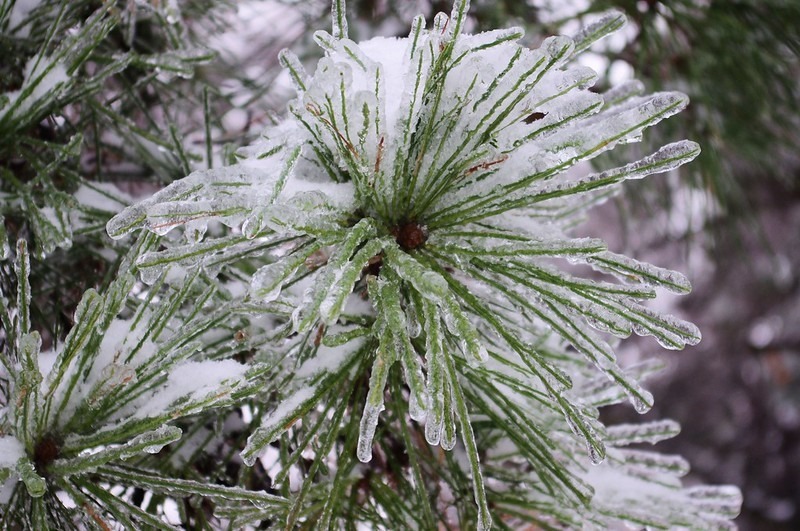Royalty-free images by Mike1 — No. 100 of over 1200 images

West Central Arkansas – After the early December 2013 ice & snow storm
This photo is from our property.
Ice Storm2
An ice storm is a type of winter storm characterized by freezing rain, also known as a glaze event or, in some parts of the United States, as a silver thaw. The U.S. National Weather Service defines an ice storm as a storm which results in the accumulation of at least 0.25-inch (6.4 mm) of ice on exposed surfaces. From 1982 to 1994, ice storms were more common than blizzards in the U.S., averaging 16 per year. They are generally not violent storms but instead are commonly perceived as gentle rains occurring at temperatures just below freezing.
The formation of ice begins with a layer of above-freezing air above a layer of sub-freezing temperatures closer to the surface. Frozen precipitation melts to rain while falling into the warm air layer, and then begins to refreeze in the cold layer below. If the precipitate refreezes while still in the air, it will land on the ground as sleet. Alternatively, the liquid droplets can continue to fall without freezing, passing through the cold air just above the surface. This thin layer of air then cools the rain to a temperature below freezing (0 °C or 32 °F). However, the drops themselves do not freeze, a phenomenon called supercooling (or forming “supercooled drops”). When the supercooled drops strike ground or anything else below 0 °C (32 °F) (e.g. power lines, tree branches, aircraft), a layer of ice accumulates as the cold water drips off, forming a slowly thickening film of ice, hence freezing rain.
While meteorologists can predict when and where an ice storm will occur, some storms still occur with little or no warning. In the United States, most ice storms are in the northeastern part of the country, but damaging storms have occurred farther south. An ice storm in February 1994 resulted in tremendous ice accumulation as far south as Mississippi, and caused reported damage in nine states. More timber was damaged than that caused by Hurricane Camille. An ice storm in eastern Washington in November 1996 directly followed heavy snowfall. The combined weight of the snow and 25 to 37 millimeters (0.98 to 1.46 in) of ice caused widespread damage and was considered the most severe ice storm in the Spokane area since 1940.
The freezing rain from an ice storm covers everything with heavy, smooth glaze ice. In addition to hazardous driving or walking conditions, branches or even whole trees may break from the weight of ice. Falling branches can block roads, tear down power and telephone lines, and cause other damage. Even without falling trees and tree branches, the weight of the ice itself can easily snap power lines and also break and bring down power/utility poles; even electricity pylons with steel frames. This can leave people without power for anywhere from several days to a month. According to most meteorologists, just one quarter of an inch of ice accumulation can add about 500 pounds (230 kg) of weight per line span. Damage from ice storms is easily capable of shutting down entire metropolitan areas.
- I am sharing some of my public domain images in periodic blog posts.
- Ice storm – Wikipedia
Notes:
- This image is also shared as public domain on Pixabay, Flickr, and Pinterest.
- Images are being shared in the sequence they were accepted by Pixabay, a royalty-free image sharing site.
- Only images specifically identified as such are public domain or creative commons on our pages.
- All other images are copyright protected by me, creative commons, or used under the provisions of fair use.

